Do you prefer fresh coleslaw to Sauerkraut in winter? Here are some ideas on how to use available resources, reduce food waste, and eat deliciously wholesome and garden-fresh leafy vegetables throughout the chilly season. Bury your cabbages in the ground to preserve them, and simply dig one out whenever needed.
Our grandparents used to do that, and we may as well follow their lead to enjoy crisp, intensely flavorful cabbage most of the year. Cabbage is a cold-weather vegetable that can survive frost, and it tastes sweeter after having been buried underground during the cold winter months. You can delight in the best cabbage you’ve ever had when you least expect it, and it is delicious when boiled and fried as well.
Cabbage yields many heads as it grows thickly, which means that you need to thin it out by replanting some of the heads in another row to provide enough room for all them to get as big as possible by the end of the growing season. Your cabbages should be ready for harvesting by fall, at which time they begin to thrive because of the colder weather.
Looking Back
People from different areas applied distinctive techniques to provide themselves with food that resembled fresh vegetables in the dead of winter many years ago.
The inhabitants of the Blue Ridge Mountains had two schools of thought: above ground and below ground. The above-ground technique involved immersing the cabbage heads in piles of soft hay or stacking them in a dome surrounded by banks of corn fodder. The below-ground option was more popular.
Homesteaders also tested what would happen to root vegetables when buried. Roots, however, rot when they’re surrounded by wet, heavy soil. We’ve since discovered that beets, carrots, horseradish, Jerusalem artichokes, parsnips, potatoes, turnips, rutabagas, and celeriac can be stored underground − in temperatures of 32 to 40 degrees Fahrenheit with 95 percent humidity.
Roots and cabbages should be buried below the freeze line in areas where the ground freezes in winter. Roots can be placed in a pit in a shady spot, inside plastic bins or rodent-proof containers, with wire mesh on top. Fill the rest of the pit with peat moss and cover the hole with plywood.
You may leave roots in the ground where they were grown if the ground doesn’t freeze in your area. Cover them with six inches of straw and a layer of plastic to protect them against the rain, and harvest as required.
Related: 17 Forgotten Preservation Hacks that Will Save You Money
The Cabbage Preservation Process
There are dozens of cabbage varieties, so read up on the one you’ve planted to know what to expect.
Pick cabbage at any size once the head is firm but before it splits, and keep the most solid, firmest, and largest heads for winter storage. The others should be used within about a month. The best varieties that last the longest are the Rio Verde and Danish Ball Head.
You want to leave the long stem or roots on when you harvest your cabbage.
Don’t wash the cabbage but prevent bruising as you take any rotten and yellow leaves off and tightly wrap the fresh green ones around the undamaged central head. Allow the cabbages to stand where they grew initially until it gets cold.
Dig a furrow of two to two-and-a-half feet in the dry ground or widen the hole where you’ve removed the cabbage.
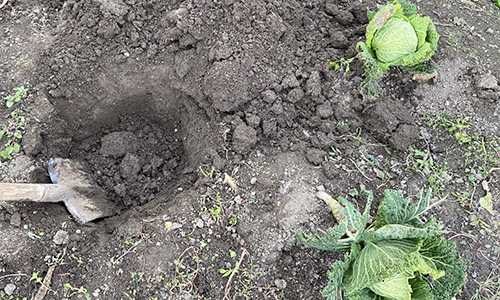 Line the hole with a layer of straw for insulation before putting the cabbage in upside down, with the roots or stem pointing up into the air.
Line the hole with a layer of straw for insulation before putting the cabbage in upside down, with the roots or stem pointing up into the air.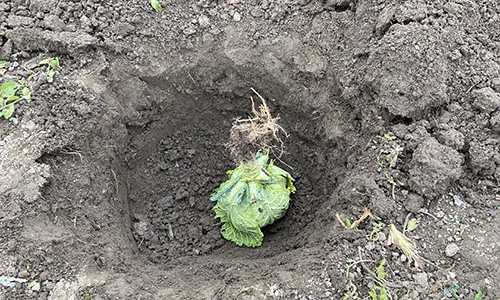
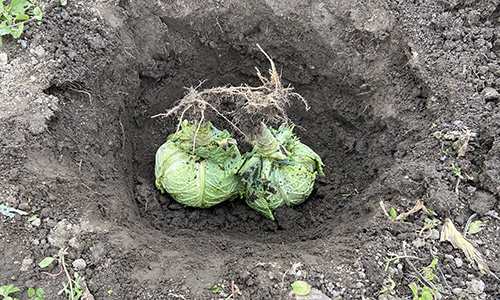 Cover the entire cabbage with approximately six to ten inches of mounded dirt − leaving a bit of the stem above the ground − but make sure to do so lightly at first to avoid warming.
Cover the entire cabbage with approximately six to ten inches of mounded dirt − leaving a bit of the stem above the ground − but make sure to do so lightly at first to avoid warming.
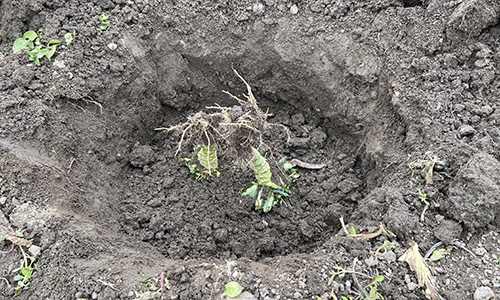 You may cover them with straw or coarse manure as the weather gets colder. Some gardeners suggest that you make the storage beds about six to eight feet wide to reach the middle from either side. You want to prevent heating as cabbages decay in warm weather.
You may cover them with straw or coarse manure as the weather gets colder. Some gardeners suggest that you make the storage beds about six to eight feet wide to reach the middle from either side. You want to prevent heating as cabbages decay in warm weather.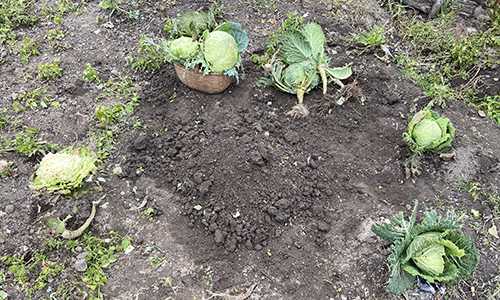 It may make it easier to get to the cabbages after the loam has frozen or when snow covers the ground if you cover the area with a tarp or burlap sacking.
It may make it easier to get to the cabbages after the loam has frozen or when snow covers the ground if you cover the area with a tarp or burlap sacking.
The cabbage goes to sleep but stays alive for months because it is refrigerated and insulated by the adjoining soil. The above-ground root absorbs the moisture it needs and becomes a signpost to show you where you buried it.
Another option is to bury your cabbages beside a barn wall or outbuilding, so you know exactly where it is. Examine your stored cabbages frequently and take out yellowing heads and those that start to smell rotten. Just loosen the dirt around it and pull it out before preparing a meal.
Medicinal Uses of Cabbage
You know that cabbage has health benefits but may not always remember why.
It is rich in Vitamin C, which boosts the immune system and heals skin conditions such as eczema and psoriasis. The high Vitamin K content contributes to teeth and bone strength, prevents blood thinning and clotting, and may help to avoid Alzheimer’s disease. Our bodies convert the beta-carotene cabbage contains into Vitamin A, which reduces the chances of cataracts and macular degeneration of the eye.
Cabbage is also a powerful source of amino acids that fight inflammation, and it supplies fiber and glutamine that is good for digestion, prevents stomach ulcers, and improves intestinal health. Potassium and calcium regulate blood sugar levels, and sulforaphane has anti-cancer properties.
The Advantages of Burying Cabbage
Your stashed cabbages will last about three to four winter months, which is exactly what you want. The outer leaves will get soft and dirty, but the earth preserves the food by protecting the head against snow and rainwater. The inside will still be fresh and deliciously edible once you’ve peeled off the outer layers.
How To Easily Cook It
You may want to try this easy fried cabbage side dish recipe, which can be done in 30 minutes and will keep for three to five months. Slice the leeks and cabbage thinly and dice raw bacon.
Add a little oil to a large, preheated pan, add the bacon, fry until the bacon is brown, and add the leeks. Add the cabbage when the leeks are soft, season with salt and pepper, and stir every few minutes until the cabbage is cooked uniformly and slightly caramelized.
Divide the dish up into small batches and freeze in an airtight container. Slow-thaw it overnight and place it in a cooking pan over medium heat whenever the craving overtakes you.
Flash freezing and other modern food technologies have wiped out homespun preservation practices for the most part. “Holing it up” can provide you with a mouthwatering, crunchy, and juicy leafy vegetable until spring. It’s a good idea to prepare your ‘burial grounds’ when fall turns to winter to enjoy the taste and reap the benefits.
You may also like:
 How I Got A 260 Pill SHTF Antibiotic Stockpile
How I Got A 260 Pill SHTF Antibiotic Stockpile
10 Plants You Should Never Plant Together (Video)
How To Safely Remove Poison Ivy And Hemlock From Your Backyard
The 24 Highest Calorie Vegetables for Your Survival Garden
How to Make Cabbage Bandages to Treat Inflammation and Joint Pain

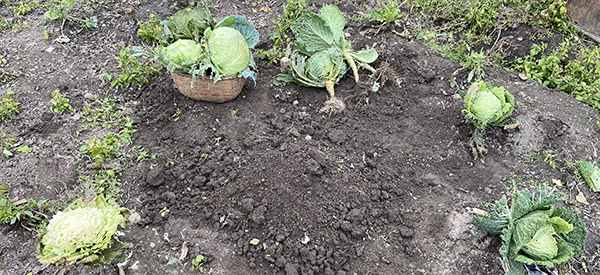













Wow! Old-timers are still doing it. As far as I know, buried cabbage is an underground delicacy for which the preservation period starts from November/ December. It can be dug up the day after it goes in the ground, or left untouched till spring.
Here’s a recipe for cabbage with noodles:
https://thetakeout.com/the-takeout-s-most-popular-recipes-of-2020-1845803590
I haven’t tried yet but it sounds good. For long term options, you could substitute ghee for the butter (and might want to anyway as it doesn’t scorch like regular butter and is shelf stable.) I also would suggest that you might want to use a sour cream sauce as an alternative for this dish.
Cabbage and noodles fried in butter is called aHaliski, very popular dish in and around Pittsburgh, Pa.
I like to add bacon or kielbasa to it sometimes and other times I mix it up by frying hash browns with onions and adding chopped cabbage and caraway seed for the last few minutes until the cabbage is soft and slightly browned.
Sabel: Fry up some hamburger, then fry cabbage and onions in the grease. Mix them and chow down niio
niio
Sorry, that should have said HALUSKI.
I think it is a Polish dish.
And a bit of trivia… Cabbage was one of the first crops cultivated by humans.
Sable – Thank you very much! I appreciate that recipe no matter how you spell it! Love anything in the cabbage family! Middle and Eastern Long Island use to be fields of potatoes in the summer and fields of cabbage in the fall! Dotted with huge potato barns and root cellars. We always knew there’d be something readily available and good to eat! Now, not so much.
Do you have some winter food preservation advice for us folks what lives in Florida?
Mr.Ed: Same as Arizona, Keep planting. We like to preserve in May and November in Arizona. niio
Where I live in the Midwest, anything under ground is food for vermin/rodents. Maybe totally surrounding them with course metal screen would solve the problem but that would also make it more difficult to dig out one at a time.
Aren’t we busy enough without having to check our soil buried food all the time to see if it is rotting?
If you want cabbage in the winter, can sour kraut. It would be much easier.
FYI, We made some very good Kraut this fall using store bought bagged cabbage. No hassle cutting it, no waste and quick cleanup afterwards.It wasn’t as “pretty” because it had some of the green leaves but it sure didn’t hurt in any other way.
Spike: Aren’t sugar beets grown as a cash crop in some states of the Midwest?
LCC, a lot of them grown in Western Nebraska. Minnesota has some. North Dakota and Colorada may also because they grow lots of odd stuff. I’m pretty sure they are grown only close to processing plants because you are hauling a lot of water and some dirt so you can’t justify long hauls.
Sugarbeet syrup is a real delicacy especially dripping on a well buttered slice of sourdough or on top a Kaiser roll.
Put it in a pot of some sort, put the right spices in, cover, bury and you will get ‘kimchi.
Looking out my window at the two feet of snow over frozen ground, I smiled.
“The high Vitamin K content contributes to teeth and bone strength, prevents blood thinning and clotting, and may help to avoid Alzheimer’s disease.”
Sorry, you can’t have it both ways. If it prevents blood thinning, it aids coagulation, not prevents it.
With heart disease so prevalent in the U.S. with tens of thousands of us taking blood thinners due to either natural occluding of blood vessels or installed blood vessel devices, why in the world would we want to counteract the medicines that we are paying for?
In the Old Corps we had a saying, “Don’t work out of your M.O.S.” M.O.S. was Military Occupational Specialty. It was your assigned job. Each branch has it. The meaning was not to attempt to do something you weren’t trained for, or offer gratuitous advice when you didn’t know what you were talking about.
I would suggest adhering to the agricultural advice in this article and ignore the medical advice. One of the major problems I have with folks who ascribe all kinds of medicinal properties to various food products is that they are not content to assign a single medicinal property but the magic beans must also cure every known disorder to man. For instance in this article it prevents Alzheimers, cataracts, macular degeneration, cancer, and ulcers and has some mystical powers over blood thinning and coagulation. Wow! I am most assuredly not a medical expert but it has always been
Just consume a healthy helping of sauerkraut or boiled cabbage every day and you will live forever.
On a more positive note, the Japanese have been leaving their daikon, the huge mild radishes that they use in so many dishes in the ground over winter for centuries. They cover the plant with rice straw before the ground freezes and apparently that is enough to keep the radish from freezing in the ground and just dig them up over the winter as they need them either for market or for self consumption. It does get cold in Japan in the winter time and the ground does freeze. The eastern portion of Japan has weather similar to the east coast of the U.S. at similar latitude. The western portion, west of the Japanese Alps has the great snowfalls that we sometimes see pictured from the storms that blow across the Japan Sea from Siberia and Manchuria.
inasmuch as preserving daikon in ground is known to Japanese farmers, and the Japanese grow a lot of cabbage, I suspect they also use this method for preserving cabbage over winter.
I looked up Vitamin K on Wikipedia and as we all know Wikipedia is never wrong. Despite that, it sometimes offers a good start to further research. Here is what Wikipedia had to say about Vitamin K.
“Vitamin K refers to structurally similar, fat-soluble vitamers found in foods and marketed as dietary supplements. The human body requires vitamin K for post-synthesis modification of certain proteins that are required for blood coagulation (K from koagulation, Danish for “coagulation”) or for controlling binding of calcium in bones and other tissues. The complete synthesis involves final modification of these so-called “Gla proteins” by the enzyme gamma-glutamyl carboxylase that uses vitamin K as a cofactor. The presence of uncarboxylated proteins indicates a vitamin K deficiency. Carboxylation allows them to bind (chelate) calcium ions, which they cannot do otherwise. Without vitamin K, blood coagulation is seriously impaired, and uncontrolled bleeding occurs. Research suggests that deficiency of vitamin K may also weaken bones, potentially contributing to osteoporosis, and may promote calcification of arteries and other soft tissues.”
It would appear to me from the coherent way the information is presented, the author or authors had some knowledge of the subject on which they wrote. It would also appear that the Vitamin K contained in cabbage would aid blood clotting which is the opposite of blood thinning. Without sufficient Vitamin K, you suffer from thinned blood. Anyone taking one of the prescription blood thinners knows that a razor nick that used to yield to a small scrap of toilet paper now needs more than just a scrap of toilet paper to control the bleeding from a razor nick. The advisory sheet that accompanies Brilinta, the new, latest blood thinner recommends eschewing shaving with a razor and using an electric razor for removing hair.
Having read this and being on a regime of Plavix, it suddenly occurs to me that I might need to give up one of my favorite foods, German sausage and sauerkraut with rye bread, washed down with a pleasant Reisling or Gewertz. I guess that is a question I should address to the cardiologist the next time I see him, although he is Persian (Iranian which they like to avoid because of the unpleasantness between the leaders of the two countries) so he may not even be familiar with sauerkraut. I asked him about camomile tea and he wasn’t familiar with what that was. There is some indication, and I emphasize the word indication that camomile tea needs to be consumed with caution if one is taking cardiac medications. No positive statement that it is contraindicated or that taking it in conjunction with cardiac medications causes palpitations or cardiac arrest or any other known cardiac symptom. From the weakness of the statement it would appear to me, although reasonable minds could certainly arrive at a different conclusion, that for some limited number of people drinking some unknown quantity of camomile tea while taking some unidentified cardiac medication might exhibit some undescribed anomaly. Now that, in my view, is a pretty thin basis for altering one’s consumption of camomile tea. I would hazard to say if you are drinking 5 gallons of camomile tea a day, and are taking some prescribed medication for a cardiac problem, you might give consideration to lowering your consumption just a tad.
Cabbage is so easy to grow and store it is a staple in all cultures. Persian food is similar to Greek food, they use cabbage instead of grape leaves for dolmas, and their version of Kraut is Shoor-E Kalam Ghermez. My wife’s hair stylist is Iranian, I have not had her cabbage but her kebab is to die for. But cabbage is so easy to grow and store and so nutritious it is silly to say it cures everything, in hard times it keeps you alive. Pork and cabbage or mutton and cabbage have subsidies cultures for thousands of years.
And your Dr. is Iranian because our culture is failing. Americans aren’t willing to study science, too hard, so we’re running out of American Drs and scientists. How many Dr. Gupta are there on TV? Steve Jobs used to say he couldn’t make I phones in America because there weren’t enough engineers here to run a factory. Course, I was a liberal arts major…
I hate Chamomile tea. Grapefruit screws up medication, too.
Once again learned something from this website. I did not know that Persians used cabbage in their diet. I can understand why Persian and Greek food might resemble each other. The Greeks and the Persians were not quite constantly but almost constantly at each other’s throats during the ascendancy of their respective eras. If the Greeks weren’t invading Persia, it was the other way round.
I wonder if Ghermez is Persian for German style?
I think Steve Jobs was just covering for his use of cheap imported labor. He couldn’t find talented U. S. engineers willing to work for what the talented Indians would work for. I had to go to a Honda dealer in the East Bay area of San Francisco and I thought I had taken the wrong off ramp and landed in downtown Bombay. I was the only non-Indian dude in there on a Saturday morning getting my van serviced. That included the staff too as far as I could tell.
In addition to not being willing to work hard to get through med school, they are not being taught enough basics to even get into med school. Education in this state has been dumbed down to the lowest common denominator. There are no advanced studies any more. At least when my kids were in school there were special advanced studies for bright kids. That made the less gifted students feel badly because they don’t qualify for advanced studies because they are struggling with basic studies. So the bright kids are put into a boring class that trudges along and somehow, by osmosis or some other magical process, the slow kids are supposed to learn how to be intelligent from the gifted kids. Well, I can tell you that’s working about as well as when triangular wheels were first tried out. Junior high is the worst. I would only teach junior high in CA public schools if I could carry a whip, a chair and a gun and the salary was mid to high seven figures to the left of the decimal with retirement and medical fully paid with a zero deductible plan for med/dent.
The other problem that developed and presented a dilemma for the socialist was the Asian kids (including Indian and southeast Asia) were all scoring very high on the SAT tests and racking up almost perfect grades in high school. What to do? They are a minority so they were entitled to special admission treatment. They were also blowing away the other ethnic groups far as admission scores and extra curricular activities. UC Berkeley other than the radical “students” who were just there to protest was very heavily Asian students. And they were cheating by actually attending class, studying and engaging in extra class work rather than protesting whatever was the latest outrage. It presented a significant dilemma for the UC Regents how to discriminate against Asian students without appearing to discriminate against a minority.
How many times in recent years has the winner of the national spelling bee been an Asian kid. some of whom didn’t speak English when they first came to this country?
Or a homeschooled kid…
IvyMike – There are many who are denied admittance to med schools here in the US because preference is given by the schools to foreign applicants in the selection process. There is a lot that remains to be done in the US higher educational system to support the Presidents America First Policy.
Just FYI Re: Vitamin K.
Mega dose(s) of vit. K is what a veterinarian will use for a dog (or any pet/ farm animal) that has ingested rat poison which causes slow internal bleeding, hence the ‘medicinal ‘blood coagulation’ aspect of the wonderful cabbage.
Hope all is well in So.Cal Chuck. (I’m from Nor.Cal, now in the far northern Great Lakes.)
Merry CHRISTmas to all.
Rob: That’s handy to know. Rat poison traditionally has been warfarin (also know as coumadin when prescribed for humans) I don’t know which came first, the rat poison or the coumadin for humans as a blood thinner. So it makes good sense to give massive doses of Vitamin K to counteract the effects of a virulent blood thinner.
Coumadin must be administered very carefully or the patient will bleed out internally with fatal results. Especially since it is given for heart problems to begin with it’s like kicking the ladder out from underneath the guy who is handing on the edge of the roof to start with.
With Plavix and Brilinta, coumadin has kind of fallen into the background although I feel certain it may still be being prescribed in certain cases. Brilinta is very expensive — well, I think $300 for a month’s supple is very expensive. Of course Gabby Nuisance spends more than that on a single bottle of wine for dinner, but then he is being supported by the taxpayers and has a direct line to the U.S. treasury via Auntie Nan Pelosi. Was it $300 million his companies got for plague reimbursement or was it just a piddly $3 million.
Dang, there I go getting political again. Sorry.
Merry Christmas to all and I hope the New Year is an improvement over this year but I am not betting the farm on that hope.
LCC- I’m sure there are readers out there other than me who really appreciate it when you get a little bit political. Reality is always a good thing. Telling it like it is, is always a good thing. Speaking up is always a good thing! Makes someone like me, basically living in a 3rd world country without leaving home feel a little bit better. May we always be able to say “Have a very Merry Christmas”, even if they put up a holiday tree.
LCC, chamomile is contraindicated if you’re taking blood thinners or if you have a heart condition (https://www.drugs.com/mtm/chamomile.html). Well it lists only warfarin, but i’d also be a bit antsy about any blood thinner.
mil: Thanks for the url to that site. It was enlightening reading. While I try not to put too much credence in such on-line articles, it did raise some interesting questions for me to ask the cardiologist on my next visit.
I looked for a date on the article and saw that it was originally copyrighted in 1996 which would make it a quarter century old. In today’s medical world that makes its timelines almost ancient history. I saw that the copyright was extended in 2018, but I don’t know if it was updated at that time. That may be the reason why coumadin was the only blood thinner mentioned. In 1996 coumadin was state of the art for blood thinners. Brilinta, the blood thinner I was originally taking has only been on the market for about two years. I understand it is an aggressive blood thinner.
Clopidogrel (How do they come up with these names? Clopidogrel sounds like a comic strip featuring a talking dog) is better known by its patented name Plavix and has been around for a while and is, I believe, most commonly prescribed.
Once again, this list and the responses to it have more than proven the worth of the time spent reading and responding to it.
Claude, thanks again for keeping this list going. It is a real public service in my opinion. Sure, some articles don’t reach the grand slam level but the discussions that follow the article oftentimes prove more valuable than the basic article. However the basic article provides the forum for the reader response and that alone provides the value even if all the information contained in the basic article is fluff. While no one else may be interested in the interaction of chamomile and blood thinners for me, that information whether accurate or not is going to lead me to do some further questioning of my cardiologist. While it may be of no import to anyone else, let me assure all that it is of vital interest to my wife and me.
Coincidentally, just because no one else expresses an interest in the topic, it just might be they are reticent to express themselves in a public forum but still find the information vitally important.
Chamomile tea is consumed by a lot of folks and a lot of folks are taking blood thinners. I doubt that I am the only one in the world not aware of the possible implications of drinking chamomile tea to wash down the Plavix tablet. Or eating a large helping of sauerkraut with the helping of German sausage.
LCC, drugs.com can be very helpful giving an overview on a lot of different drugs including pics of what they look like. I used it a lot for work to get general info. I told my friend about it who was an OR nurse. She found it helpful when she had a patient who couldn’t remember what medication she took. She asked the patient if she knew what she was taking it for, and then showed her the images of the different pills. She was able to select which one very easily.
The site is pretty US-centric, but it can still be handy.
As you can see, I am a pharmacist. There is an entire clotting system in the body dependent upon vitamin K. Warfarin (brand Coumadin) acts by lowering the plasma (blood) levels of these vitamin K dependent clotting factors. Giving vitamin K or consuming foods high in vitamin K diminishes the effectiveness of warfarin. Vitamin K is given to patients who have taken too much warfarin and are in danger of internal bleeding. This is why the vet gives farm animals vitamin K when they get into rat poison, which is often warfarin based. Other, newer medications work on different parts of the clotting cascade including platelets and Factor X (ten) to “thin the blood.” These have gained popularity because warfarin is hard to control (people like to eat stuff they shouldn’t (like cabbage and green leafy veggies), warfarin is notorious for interacting with other medications (highly protein bound) and it requires regular blood work. Hope that helps —
DopeyDoc – Thank you for providing insight and clarification here. Your expertise is much appreciated. Pharmaceuticals are complicated and not anything anyone should fool around with unless they really know what they’re doing and have a script.
?? all is sound wisdom Chuck.
Although our family name is French I’d happily joined you in a German sausage and sauerkraut and rye bread meal. I don’t much care for cooked cabbage…the taste or the smell while it’s being cooked…guess if I was hungry enough I could eat it but I’d have to be awfully hungry.
I really don’t like to think about it but being really hungry may be something a lot of us will experience in the future so this article may be something we all should bookmark.
Buried cabbage? Sounds like what the Koreans do to make Kimshe. I spent a year at Osan Air Base and never really got used to that smell.
Tarheel: No, this is to keep cabbage fresh. niio
We would gather wagon loads of leaves out of the brush, then bury the cabbage in that. A thick layer of leaves on the north side of the barn, pack leaves around each head. I think up to 4 heads high. We were still huckstering fresh cabbage at Easter the next year. Winter temps did drop close to zero a night or two, but the cabbage wasn’t harmed. niio
Red – When the hungry hordes come around your place, they’d pass right by that cabbage. Same goes with most of your basic root vegetables, especially those you can keep hidden in the field. Heck, they wouldn’t know what to do with any of it if it’s not in a box with microwave directions!
CC: Nope. Here, cabbage is a treat. Most folks pride themselves that Granny and Papi were rancheros or farmer. for a hidden garden, always use eatable ornamentals. It’s going on 2 years since amaranth was plated in a flower bed for greens and grain, but I still get asked what was that awesome flower They look, wow, pretty nasturtiums and never mind the salads that came out of it. Last year people complimented me on those nice bushes in bloom. Radishes can get 5 feet tall and bloom continually till the heat stops them. Every once in a while I’m asked if they can have some sweet potato leaves. Good steamed! On and on. Most they know about, but ground cherries (wild tomatillos) look too pretty to be eaten. I live in a town where maybe half the folks are preppers. I wish I could raise cabbage. It sells for 59c lb at walmart! niio
They look, wow, pretty nasturtiums and never mind the salads that came out of it. Last year people complimented me on those nice bushes in bloom. Radishes can get 5 feet tall and bloom continually till the heat stops them. Every once in a while I’m asked if they can have some sweet potato leaves. Good steamed! On and on. Most they know about, but ground cherries (wild tomatillos) look too pretty to be eaten. I live in a town where maybe half the folks are preppers. I wish I could raise cabbage. It sells for 59c lb at walmart! niio
Red: Would kales do better in your climate? This one is awesome looking and supposed to be super nutritious.
https://www.rareseeds.com/store/vegetables/bulk-vegetables/lettuce-and-greens/nero-di-toscana-cabbage-dinosaur-or-lacinato-kale
Miz Kitty, merry Christmas! I planted it, but have yet to see it come up. Collards do well in winter and summer here. Heat resistant is better than cold resistant. I have to cage the brus. sprouts. Quail ate the leave off them but the plants are OK. It dropped in places to 29 F last night, but no sign of frost damage today on tomatoes of chimayo chilis. I’m going to try another pack of beets and one of cabbage. None of those came up in the seed beds. they may be waiting for better weather to try, tho. But, it’s a pretty short window here for things like that. The rye, peas, and radishes look OK. Nothing is burrowing where black radishes are planted with the rest–German horseradish, definitely cleaned out the sinuses of those javelina pigs One decided to taste some of the chilis. Nice sign where it took off running! Very deep tracks in the dirt
One decided to taste some of the chilis. Nice sign where it took off running! Very deep tracks in the dirt  And, a prosperous New Year! niio
And, a prosperous New Year! niio
I bury a 10 gallon metal trash can up to the rim and store cabbage in that with just the lid bove ground. The can protects it from rodents and a layer of snow keeps it from freezing. Root vegetables are stored the same way in anbother can. In winter I dig through the snow to get in. Anything that’s still there when the snow melts in April is still good.
OK, two thoughts:
1: Underground pests…moles, gophers, etc……
2: Worms and other underground insects that will also eat your buried items if not enclosed in something other than dirt.
People used to cover cabbage with leaves all winter. I don’t remember if it was oak leaves or some other kind. They last a long time that way.